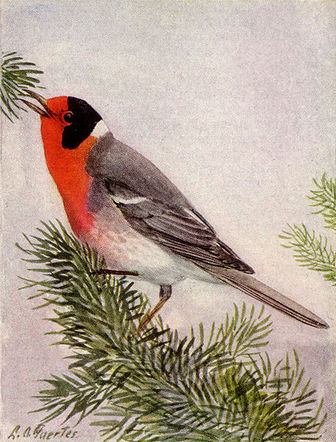Red-faced warbler
Mature Red-faced Warblers are small birds, 14 cm long. They are light gray on top with a white rump and a white underside. The face, neck, and upper breast are all bright red, while the crown and sides of the head are black. The spot on the back of the head where the black crown and gray back meet is sometimes speckled gray, or sometimes plain white. They also have a quirky habit of flicking their tail sideways while feeding.

The Red-faced warbler is classified as Least Concern. Does not qualify for a more at risk category. Widespread and abundant taxa are included in this category.
Red-faced Warblers have slate-gray backs, white underparts, and white rumps. The two sexes are similar in appearance, but the faces and upper breasts of females are orange-red, compared with the scarlet red color of males. Distribution and Population Trends Red-faced Warblers breed only in Arizona, New Mexico, and adjacent western Mexico at elevations roughly between 6,600 and 9,200 feet. This species can be found year-round in the Mexican states of Sinaloa and Durango. More
The Red-faced Warbler (Cardellina rubrifrons) is a species of New World warbler. Mature Red-faced Warblers are small birds, 14 cm (5½ inches) long. They are light gray on top with a white rump and a white underside. The face, neck, and upper breast are all bright red, while the crown and sides of the head are black. The spot on the back of the head where the black crown and gray back meet is sometimes speckled gray, or sometimes plain white. More
The Red-faced Warbler has a large range, estimated globally at 390,000 square kilometers. Native to El Salvador, Guatemala, Honduras, the United States and Mexico, this bird prefers subtropical or tropical forest ecosystems. The global population of this bird is estimated at 430,000 individuals and does not show signs of decline that would necessitate inclusion on the IUCN Red List. For this reason, the current evaluation status of the Red-faced Warbler is Least Concern. More
(Parulidae) Red-faced Warbler Head Illustration Head * Bill Shape: All-purpose * Eye Color: Dark brown. More
The Red-faced Warbler is a colorful bird of the Mexican mountains. In the United States it is found only in the high elevation forests of Arizona and New Mexico. More
Red-faced Warblers are locally common in mountain forests of conifers, spruce, and oak 2,000-3,000 m (6,500 to 9,000 feet) above sea level. In summer they frequent northern Mexico and range up into the states of Arizona and New Mexico – (the Madrean sky islands). During the winter months they migrate south into southern Mexico and the Central American nations of El Salvador, Guatemala, and Honduras. They are permanent residents of the central and southern mountains of western Mexico, the range called Sierra Madre Occidental. More
* Red-faced Warbler videos on the Internet Bird Collection * Red-faced Warbler photo; Article firefly forest * Red-faced Warbler photo gallery VIREO Photo-High Res * Stamps (for El Salvador) with RangeMap * Photo-High Res * USGS Copyright: Wikipedia. This article is licensed under the GNU Free Documentation License. It uses material from Wikipedia. More
A beautiful bird, the Red-faced warbler is found in the US only in New Mexico & Arizona. They breed in high-elevation forests and build their nests on the ground, hidden in the roots of maple trees. More
The Red-faced Warbler (Cardellina rubrifrons) is essentially a Mexican species which, within the U.S., only occurs in the mountains of southern New Mexico and Arizona. There are about 20 records of wandering birds in west Texas as well. It is a striking bird with a lovely song which graces our visits to its mountain home. The top 10 images on this page were taken on Mt. Lemon, Pima Co. More
Red-faced Warbler occurs near the northern periphery of its breeding range in southern and central New Mexico. State populations are vulnerable to disturbance or loss of favored montane forest and riparian habitat, inappropriate grazing practices, and interrupted fire regimes. Associated Species - Whip-poor-will (BC2), Broad-tailed Hummingbird (SC2), Cordilleran Flycatcher (SC2), Violet-green Swallow, Mexican Chickadee (BC2), Red-breasted Nuthatch, Hermit Thrush, Olive Warbler (BC2), Yellow-eyed Junco (BC1). More

Family : Parulidae
Genus : Cardellina
Species : rubrifrons
Authority : (Giraud, 1841)

